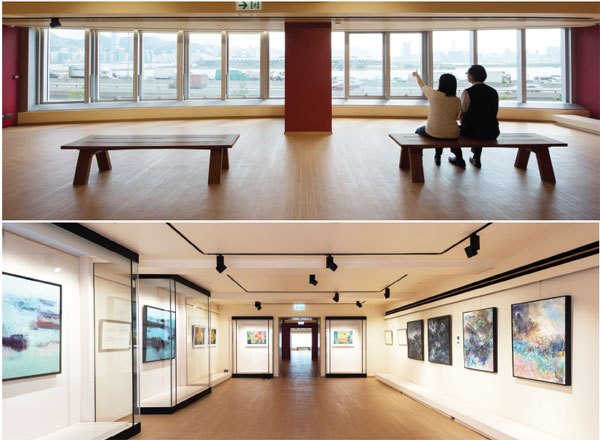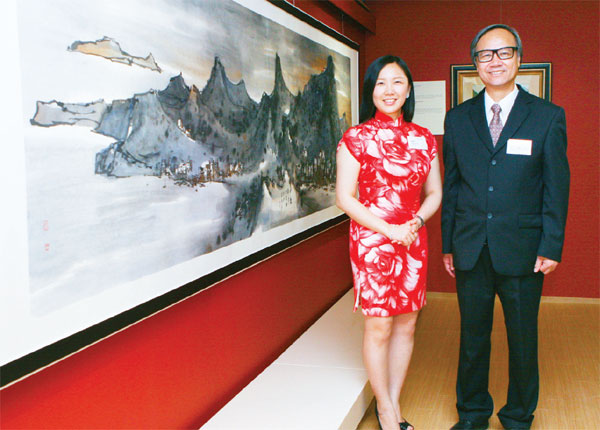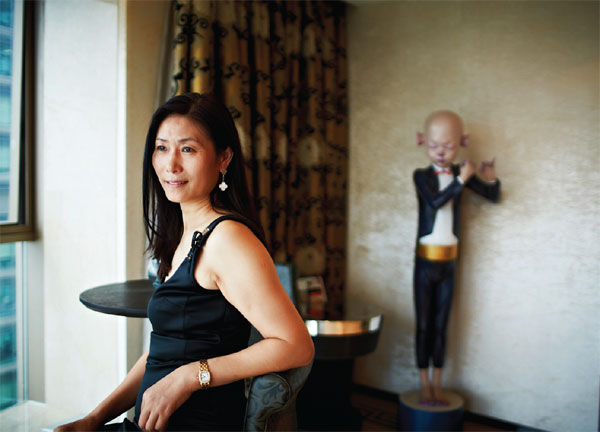Come, see my treasures
Updated: 2016-04-21 07:40
By Chitralekha Basu(HK Edition)
|
|||||||||
What's keeping HK's big-time collectors of art from sharing their possessions with the public? What's the way ahead for the city's fledgling privately run art museum? Chitralekha Basu writes.
It's difficult to rationalize Hong Kong not having a world-class museum of art. Think of the humongous crowds (over 60,000 in three days) who braved rough weather to check out Art Basel Hong Kong last March. It doesn't seem to add up.
Say you wanted to re-acquaint yourself with the fluid grace of Xu Beihong's ink-and-wash horses or the guileless satire in Yue Minjun's multiple self-portraits, maybe introduce a friend to the mysterious yet becalming stream of words passing across walls and floors in installations by Hong Kong's very own Tsang Kin-wah. Your chances of finding them in a city museum are practically next to nil. With Hong Kong Museum of Art closed for a major renovation until at least 2018, and the eagerly anticipated M+ museum of visual culture not likely to open before 2019, Hong Kong - now the third largest market for art retail after New York and London - does not have a functional institution offering a comprehensive view of the evolution of the art scene in this part of the world.
|
Sun Museum in Kwun Tong, which completes a year in May, depends on private collectors in a big way to source their exhibits. Photos Provided to China Daily |


|
Simon Suen Foundation Chairperson Chloe Suen (left) and museum director Yeung Chun-tong are the two pillars of Sun Museum. |
|
Long Museum proprietor Wang Wei says she is keen to work together with Hong Kong museum owners. |
Even as more private museums come up across the Chinese mainland, and Wang Wei and Liu Yiqian - arguably China's most visible art-buying couple - get three museums (two in Shanghai and a third in Chongqing) going in just four years, Hong Kong's heavyweight private collectors do not seem that interested in opening private museums, although some of them, like William Lim, is known to allow limited public access to his purpose-built loft in Wong Chuk Hang, Hong Kong Island.
In a city perennially short of living quarters and bogged down by absurdly high rentals, locating a suitable, and affordable, museum space would be an uphill task. Art adviser Jehan Chu of Vermillion Art, however, feels paucity of land may not be such an insurmountable problem, as private museums are essentially the result of the founder's "passion and commitment". Citing the example of the Mori museum, built on the terrace of a shopping center by its proprietor, in the heart of the Ropponggi Hills shopping district in Tokyo, Chu says, "Many among Hong Kong's realtors are capable of dedicating five floors of their next building project to set up an integrated museum. It's a proven model."
Johnson Chang Tsong-zung, director of Hanart TZ Gallery, agrees. "Apart from the common knowledge that most of us are at the mercy of powerful landlords, our government's mercenary attitude towards the use of land, heritage or commercial, belittles the power of sophisticated culture."
Until such time as Hong Kong's realtors are inspired to play a social role in promoting the awareness and appreciation of art, or tycoons like Li Ka-shing or Allan Zeman pitch in with their support, the possibility of Hong Kong getting a privately-owned, top-notch museum of art is likely to remain a pipe dream, according to Chu. Adrian Cheng, who built the K11 art mall, placing items from his collection as exhibits at strategic points for people to admire between shopping is perhaps the only Hong Kong tycoon who has worked out a way of sharing his art with the public, says Chu. "But it would be more accurate to say he has built culture into his business model, which is great but not quite the same thing."
Loaning out
There is no dearth of museum-worthy artworks in private hands in Hong Kong, assures Chang. "Hong Kong has enough private holdings to make museums envious," he says.
But then running a museum is way more complicated than building an art collection - a daunting prospect for most collectors, even if they had the money to do it. Besides most connoisseurs of art prefer to admire their possessions in private, as that perhaps is the whole point of bringing a piece of art home.
"Collectors by nature, at least in Asia, tend to be a little more private," says Mark Saunderson, who runs the Asia Contemporary Art Show. "Art is very, very personal. It is not like buying an expensive yacht and mine being bigger than yours. Art appeals to a different psyche."
Both Chu and Adeline Ooi, Art Basel's Asia director, point to the presence of collectors in Hong Kong who have accumulated a respectable stash and are known to loan pieces selected from them out to museums and touring exhibitions. Besides Lim, the list includes Lawrence Chu, Victor Lo Chung-wing, Alan Lo and Evan Chow, collectors who lend their possessions for the enjoyment of a wider audience.
"Look at Dominique and Sylvain Levy," remarks Ooi. "They have a huge Asian art collection. They are much happier loaning their works and letting them pop up in other places."
Facilitating art education
The good taste and generosity of spirit of collectors such as them is the mainstay of Hong Kong's new-age private museums, like Sun Museum in Kwun Tong which opened about a year ago. Possibly the only privately-run museum of art in town (not counting a few others catering to more niche interest areas, such as Liang Yi Museum which showcases antique Chinese furniture, or F11 museum of photography), Sun Museum, funded by the Simon Suen Foundation, follows the unconventional model of sourcing its exhibits from collectors and artists themselves, rather than using the space to showcase the not-too-negligible Chinese ink and brush paintings owned by the Suen family.
Chloe Suen, who chairs the trust in charge of the museum, covering a modest 5,000 square feet exhibition space, says they had very clear, realistic goals from the very outset. "We set out to create a platform where artists, collectors and the public can come together and appreciate and learn more about the art and culture of Hong Kong as well as the Chinese mainland," says Suen.
The thrust, Sun Museum's director, Yeung Chun-tong, indicates, is not so much on collecting the noisiest art piece in the market, but rather helping to build arts literacy.
"We cannot afford to put up an exhibition featuring the national treasures and we do not have such an ambition," says Yeung. "On the other hand, we can put up a show of the reproductions of these national treasures and teach the audience how to appreciate them."
Such orientation sessions are usually mounted across different platforms, featuring lectures, slide shows and replicas. Yeung, who usually makes these presentations, says, "My talk is an exhibition in itself, one that can speak to people. Each talk can be regarded as a thematic exhibition that lasts just two hours."
In less than a year since its inception, the museum has registered over 6,000 footfalls, including visitors from the mainland ("We sometimes find renminbi notes left in the donation box," quips Yeung) and Taiwan.
Particularly keen to attract a young demographic, the museum sends out publicity material of exhibitions to secondary schools, and usually subsidizes the transport costs to and from the gallery.
"We try to give them absolutely no excuse not to come," says Suen. "It is a very challenging task to get them here, as Hong Kong students are forever pressed for time. Additionally the teacher and the curator have to work together."
Resource sharing
Suen says she would be happy to see more private museums come up in Hong Kong. "For us it is not about competition but being a part of Hong Kong's art eco system." She says she would like to see the privately-funded museum sector to grow as robust as the city's auction houses and art galleries already are. In fact, she would not mind building a fraternal relationship with private museums that come up in Hong Kong in the future. In an interview given to a local paper some time back she had advocated setting up a private museum council with government support, which was misconstrued by some readers as another way of pitching for monetary backing from the government.
The idea of mixing private museums with public funds could be "dangerous", says Jehan Chu. "To private museum owners asking for government support I would say 'be careful what you wish for'. It's simpler when funds are raised privately."
Chu, who works closely with the city's non-profit platforms for artists, says two of them -Design Trust and Things That Can Happen - do not receive any public funds and are none the worse for it. "I find these to be the most interesting and most flexible organizations," says Chu. "When I talk about private museums, for me there is no crossover."
Suen says her private museum council idea was never on the lines of "so we have set up a museum, now fund us, but more like, we have an excellent exhibition coming up, would you consider collaborating with us?"
"A council can bring together museum professionals and promote cooperation between them. That way there will be enhanced activities and sharing in the local museum circles," says Suen, who is in favor of extending the ambit to include university museums as well. "If there is a museum council, it would be possible to make optimum use of resources in terms of training of future professionals, and better dissemination of our educational activities."
And when that happens Hong Kong can enlist the support of at least one successful museum entrepreneur from the Chinese mainland. Wang Wei of Long Museum says she is eager "to work together with Hong Kong museum owners and share the story of how we built a successful model with the public". She is particularly keen to have more women take the initiative in museum building. "I was just a housewife with no knowledge of art when I started. I would like to share my knowledge with more women like me and we can learn together."
Contact the writer at
basu@chinadailyhk.com
(HK Edition 04/21/2016 page8)


